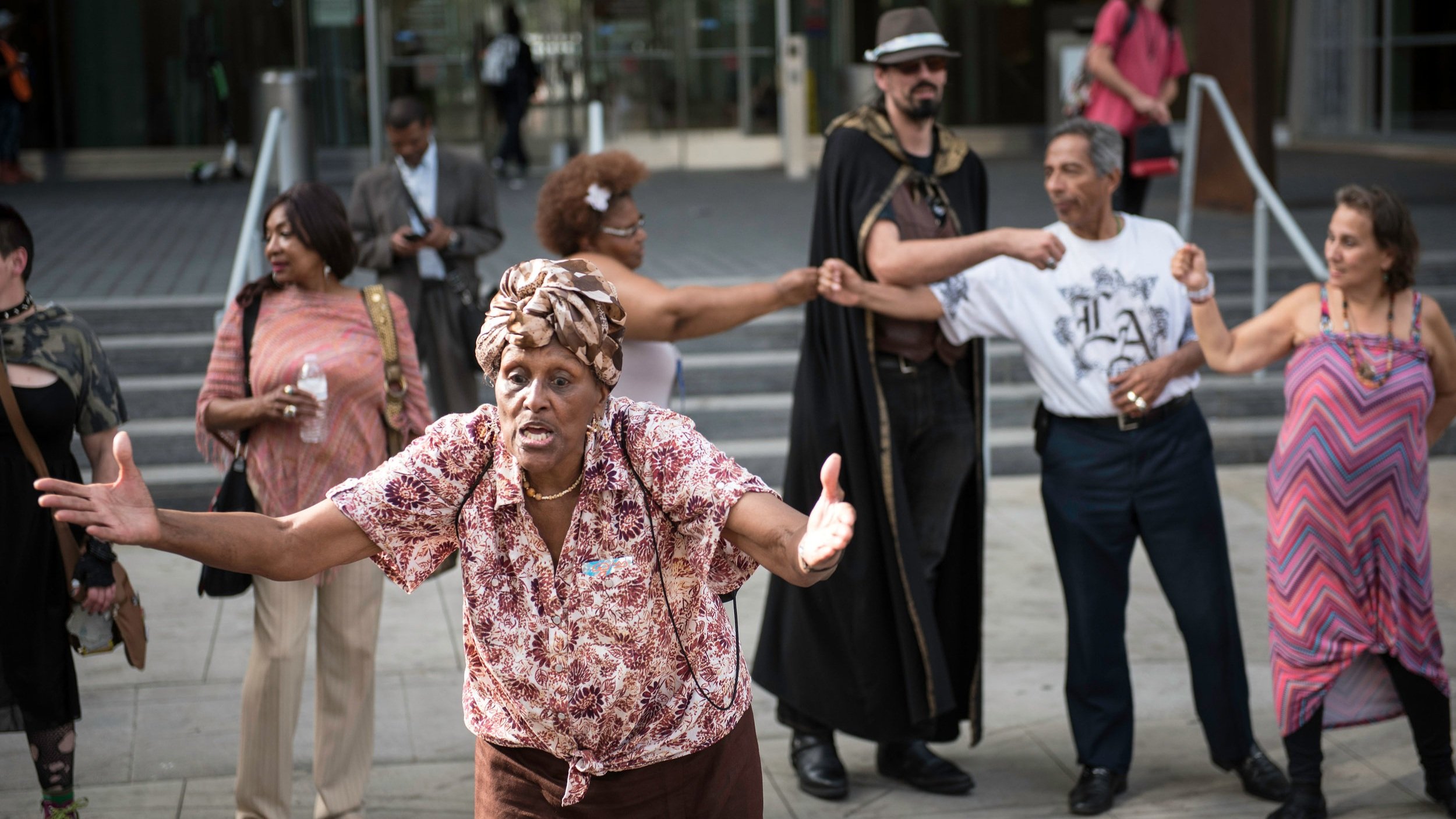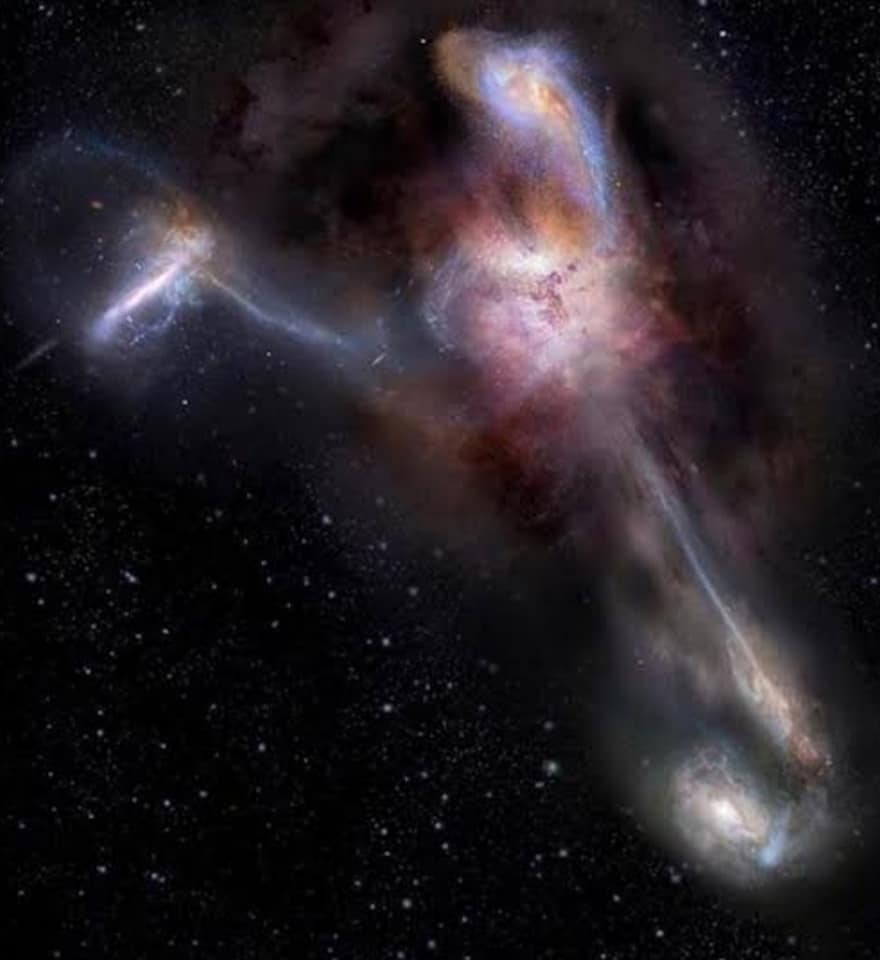Blog
Zamya Theater will be rehearsing for The zAmya Zone – Homelessness Space Program at the Opportunity Center at Catholic Charities in St Paul. Monday 4-25-22 3-5pm

more...
The ultra-diffuse galaxy GAMA 526784 appears as a tenuous patch of light in this image from the NASA/ESA Hubble Space Telescope. This wispy object resides in the constellation Hydra, roughly four billion light-years from Earth. Ultra-diffuse galaxies such as GAMA 526784 have a number of peculiarities. For example, their dark matter content can be either extremely low or extremely high — ultra-diffuse galaxies have been observed with an almost complete lack of dark matter, whereas others consist of almost nothing but dark matter. Another oddity of this class of galaxies is their anomalous abundance of bright globular clusters, something not observed in other types of galaxies. Hubble captured GAMA 526784 with the Advanced Camera for Surveys (ACS), which was installed in 2002 by astronauts during Hubble Servicing Mission 3B. Since then, the instrument has played a pivotal role in some of Hubble’s most impressive scientific results, including capturing the Hubble Ultra Deep Field. The ACS has also photographed Pluto in advance of the New Horizon mission, observed gargantuan gravitational lenses and found fully formed galaxies in the early Universe. This image comes from a set of Hubble observations designed to shed light on the properties of ultra-diffuse galaxies. Hubble’s keen vision allowed astronomers to study GAMA 526784 in high resolution at ultraviolet wavelengths, helping to gauge the sizes and ages of the compact star-forming regions studding the galaxy.

Carl Allen (born April 25, 1961) is an American jazz drummer. Allen attended William Paterson University.
He has worked with a wide variety of musicians, including Freddie Hubbard, Jackie McLean, George Coleman, Phil Woods, the Benny Green Trio and Rickie Lee Jones.
It was with Green that Allen met bassist Christian McBride. The two have teamed up frequently, working for many combos of big name leaders. McBride recruited Allen for his band, Christian McBride & Inside Straight. Allen is that quintet’s drummer for both its first recording, Kinda Brown, and its road tours.
In 1988 Allen and Vincent Herring founded Big Apple Productions, which produced several albums featuring young jazz performers.
He joined the faculty of The Juilliard School in 2001, and became the Artistic Director of Jazz Studies in 2008. He was replaced as director by Wynton Marsalis in 2013, and left Juilliard at the end of the academic year.
In 2011, Allen appeared as himself in two episodes of the HBO series Tremé, in a studio recording scene in New York City.
In 2014, he formed his own group, The Art of Elvin to pay tribute to Art Blakey and Elvin Jones. The band debuted at the Percussive Arts Society (PAS) conference in Indianapolis, Indiana with Allen on drums, Freddie Hendrix (trumpet), Tivon Pennicott (tenor sax), Xavier Davis (piano), Yasushi Nakamura (bass).
In 2021, Allen joined the faculty of the UMKC Conservatory in Kansas City as the William D. and Mary Grant Endowed Professor of Jazz Studies.
https://www.youtube.com/watch?v=8lVeJd2lvqA
more...Albert Nelson (April 25, 1923 – December 21, 1992), known by his stage name Albert King, was an American blues guitarist and singer whose playing influenced many other blues guitarists. He is perhaps best known for the popular and influential album Born Under a Bad Sign (1967) and its title track. He, B.B. King, and Freddie King, all unrelated, were known as the “Kings of the Blues”. The left-handed King was known for his “deep, dramatic sound that was widely imitated by both blues and rock guitarists.”
He was once nicknamed “The Velvet Bulldozer” because of his smooth singing and large size–he stood taller than average, with sources reporting 6 ft 4 in (1.93 m) or 6 ft 7 in (2.01 m), and weighed 250 lb (110 kg)–and also because he drove a bulldozer in one of his day jobs early in his career.
King was inducted into the Blues Hall of Fame in 1983. He was posthumously inducted into the Rock and Roll Hall of Fame in 2013. In 2011, he was ranked number 13 on Rolling Stone‘s 100 Greatest Guitarists of All Time.
Albert King was born on a cotton plantation in Indianola, Mississippi. During childhood he sang at a church with a family gospel group, in which his father played the guitar. One of 13 children, he grew up picking cotton on plantations near Forrest City, Arkansas, where the family moved when he was eight years old.
more...Ella Jane Fitzgerald (April 25, 1917 – June 15, 1996) was an American jazz singer, sometimes referred to as the “First Lady of Song”, “Queen of Jazz”, and “Lady Ella”. She was noted for her purity of tone, impeccable diction, phrasing, timing, intonation, and a “horn-like” improvisational ability, particularly in her scat singing.
After a tumultuous adolescence, Fitzgerald found stability in musical success with the Chick Webb Orchestra, performing across the country but most often associated with the Savoy Ballroom in Harlem. Her rendition of the nursery rhyme “A-Tisket, A-Tasket” helped boost both her and Webb to national fame. After taking over the band when Webb died, Fitzgerald left it behind in 1942 to start her solo career. Her manager was Moe Gale, co-founder of the Savoy, until she turned the rest of her career over to Norman Granz, who founded Verve Records to produce new records by Fitzgerald. With Verve she recorded some of her more widely noted works, particularly her interpretations of the Great American Songbook.
While Fitzgerald appeared in movies and as a guest on popular television shows in the second half of the twentieth century, her musical collaborations with Louis Armstrong, Duke Ellington, and The Ink Spots were some of her most notable acts outside of her solo career. These partnerships produced some of her best-known songs such as “Dream a Little Dream of Me“, “Cheek to Cheek“, “Into Each Life Some Rain Must Fall“, and “It Don’t Mean a Thing (If It Ain’t Got That Swing)“. In 1993, after a career of nearly 60 years, she gave her last public performance. Three years later, she died at the age of 79 after years of declining health. Her accolades included fourteen Grammy Awards, the National Medal of Arts, and the Presidential Medal of Freedom.
Fitzgerald was born on April 25, 1917, in Newport News, Virginia. She was the daughter of William Fitzgerald and Temperance “Tempie” Henry, both described as “mulatto” in the 1920 census. Her parents were unmarried but lived together in the East End section of Newport News for at least two and a half years after she was born. In the early 1920s, Fitzgerald’s mother and her new partner, a Portuguese immigrant named Joseph da Silva,moved to Yonkers, in Westchester County, New York.
more...Eugene Earl Bostic (April 25, 1913 – October 28, 1965) was an American jazz alto saxophonist and a pioneer of the post-war American rhythm and blues style. He had a number of popular hits such as “Flamingo”, “Harlem Nocturne“, “Temptation”, “Sleep”, “Special Delivery Stomp”, and “Where or When“, which all showed off his characteristic growl on the horn. He was a major influence on John Coltrane.
Bostic was born in 1913 in Tulsa, Oklahoma. He turned professional at the age of 18 when he joined Terence Holder’s “Twelve Clouds of Joy”. Bostic made his first recording with Lionel Hampton in October 1939, with Charlie Christian, Clyde Hart and Big Sid Catlett. Before that, he performed with Fate Marable on New Orleans riverboats. Bostic graduated from Xavier University in New Orleans. He worked with territory bands as well as Arnett Cobb, Hot Lips Page, Rex Stewart, Don Byas, Charlie Christian, Thelonious Monk, Edgar Hayes, Cab Calloway, and other jazz luminaries. In 1938, and in 1944, Bostic led the house band at Smalls Paradise. While playing at Small’s Paradise, he doubled on guitar and trumpet. During the early 1940s, he was a well-respected regular at the famous jam sessions held at Minton’s Playhouse. He formed his own band in 1945 and made the first recordings under his own name for the Majestic label. He turned to rhythm and blues in the late 1940s. His biggest hits were “Temptation“, “Sleep”, “Flamingo“.
more...Linda Womack (née Cooke; born April 25, 1953), now known as Zeriiya Zekkariyas, is an American singer and songwriter. She is the daughter of soul singer Sam Cooke. She later had a successful career as half of the duo Womack & Womack with her husband Cecil Womack.
Linda Womack (née Cooke) is the eldest child of Barbara Campbell and Sam Cooke, born on April 25, 1953. Her parents married in 1958. In December 1964, when she was 11 years old, her father was killed. Soon after, her mother married Cooke’s protégé Bobby Womack on March 5, 1965. In 1970, Barbara shot at him after she discovered he was apparently sexually abusing Linda. According to Womack, Linda never spoke to her mother again after that incident.
In 1972, Linda co-wrote Bobby Womack’s 1972 hit song “Woman’s Gotta Have It“. In 1979, she signed to Capricorn Records and went on the road with him. They planned to collaborate for her debut album. She gained renown as a songwriter of soul songs in the late 1970s and ’80s, with “Love Bankrupt”, released by Patti LaBelle; and the ballad “New Day” by soul singer and jazz guitarist, George Benson.
Linda married Bobby’s brother Cecil Womack, and together they had a successful recording career under the name Womack & Womack. Their first album, Love Wars, released by Elektra Records, was a critical hit. “Baby I’m Scared of You” was a Top 40 R&B single. Other albums included Radio M.U.S.I.C. Man (Elektra 1985), Starbright (Manhattan EMI 1986), Conscience (Island 1988) and Family Spirit on Arista/RCA in 1991. Their 1988 single “Teardrops” from the album Conscience was a worldwide hit. The song, written by Linda and Cecil (as Womack and Womack), featured Linda on lead vocals. The 1993 album Transformation Into The House Of Zekkariyas was their last as Womack & Womack.
In the 1990s, Linda and her family moved to South Africa. She records with her seven children as The House of Zekkariyas. Her husband died on January 25, 2013 in South Africa, aged 65.
more...WISE J224607.57−052635.0 (or W2246−0526 for short) is an extremely luminous infrared galaxy (ELIRG) which, in 2015, was announced as the most luminous known galaxy in the Universe. The brightness is 350 trillion times that of the Sun (349×1012L☉), and the merger of smaller nearby galaxies may be contributing to its brightness. The light is generated by a quasar 10 billion times the mass of the Sun. The optical and ultraviolet light emitted by the accretion disc around the quasar’s supermassive black hole is absorbed by the galaxy’s dust and remitted in the infrared. The galaxy releases 10,000 times more energy than the Milky Way galaxy, although WISE J224607.57–052635.0 is the smaller of the two. WISE J224607.57–052635.0 has a light-travel distance of 12.5 billion light years from it to Earth. The galaxy was discovered using the Wide-field Infrared Survey Explorer.

John Christopher Williams AO OBE (born 24 April 1941) is an Australian virtuosic classical guitarist renowned for his ensemble playing as well as his interpretation and promotion of the modern classical guitar repertoire. In 1973, he shared a Grammy Award in the Best Chamber Music Performancecategory with fellow guitarist Julian Bream for Together (released in the US as Julian and John (Works by Lawes, Carulli, Albéniz, Granados)).Guitar historian Graham Wade has said that “John is perhaps the most technically accomplished guitarist the world has seen.
https://www.youtube.com/watch?v=B5y-2rUcsoU
more...Joe Henderson (April 24, 1937 – June 30, 2001) was an American jazz tenor saxophonist. In a career spanning more than four decades, Henderson played with many of the leading American players of his day and recorded for several prominent labels, including Blue Note, Milestone, and Verve.
Born in Lima, Ohio, United States, Henderson was one of five sisters and nine brothers. He was encouraged by his parents Dennis and Irene (née Farley) and older brother James T. to study music. He dedicated his first album to them “for being so understanding and tolerant” during his formative years. Early musical interests included drums, piano, saxophone and composition. According to Kenny Dorham, two local piano teachers who went to school with Henderson’s brothers and sisters, Richard Patterson and Don Hurless, gave him a knowledge of the piano. He was particularly enamored of his brother’s record collection. It seems that a hometown drummer, John Jarette, advised Henderson to listen to musicians like Lester Young, Stan Getz, Dexter Gordon and Charlie Parker. He also liked Flip Phillips, Lee Konitz and the Jazz at the Philharmonic recordings. However, Parker became his greatest inspiration. His first approach to the saxophone was under the tutelage of Herbert Murphy in high school. In this period of time, he wrote several scores for the school band.
more...John Arnold Griffin III (April 24, 1928 – July 25, 2008) was an American jazz tenor saxophonist. Nicknamed “the Little Giant” for his short stature and forceful playing, Griffin’s career began in the mid-1940s and continued until the month of his death. A pioneering figure in hard bop, Griffin recorded prolifically as a bandleader in addition to stints with pianist Thelonious Monk, drummer Art Blakey, in partnership with fellow tenor Eddie “Lockjaw” Davis and as a member of the Kenny Clarke/Francy Boland Big Band after he moved to Europe in the 1960s. In 1995, Griffin was awarded an Honorary Doctorate of Music from Berklee College of Music.
Griffin studied music at DuSable High School in Chicago under Walter Dyett, starting out on clarinet before moving on to oboe and then alto saxophone. While still at high school at the age of 15, Griffin was playing with T-Bone Walker in a band led by Walker’s brother.
Alto saxophone was still his instrument of choice when he joined Lionel Hampton‘s big band, three days after his high school graduation, but Hampton encouraged him to take up the tenor, playing alongside Arnett Cobb. He first appeared on a Los Angeles recording with Hampton’s band in 1945 at the age of 17.
more...A gorgeous spiral galaxy, Messier 104 is famous for its nearly edge-on profile featuring a broad ring of obscuring dust lanes. Seen in silhouette against an extensive central bulge of stars, the swath of cosmic dust lends a broad brimmed hat-like appearance to the galaxy suggesting a more popular moniker, the Sombrero Galaxy. This sharp view of the well-known galaxy was made from over 10 hours of Hubble Space Telescopeimage data, processed to bring out faint details often lost in the overwhelming glare of M104’s bright central bulge. Also known as NGC 4594, the Sombrero galaxy can be seen across the spectrum, and is host to a central supermassive black hole. About 50,000 light-years across and 28 million light-years away, M104 is one of the largest galaxies at the southern edge of the Virgo Galaxy Cluster. Still, the spiky foreground stars in this field of view lie well within our own Milky Way.

Roy Kelton Orbison (April 23, 1936 – December 6, 1988) was an American singer, songwriter, and musician known for his impassioned singing style, complex song structures, and dark, emotional ballads. His music was described by critics as operatic, earning him the nicknames “The Carusoof Rock” and “The Big O.” Many of Orbison’s songs conveyed vulnerability at a time when most male rock-and-roll performers chose to project masculinity. He performed while standing motionless and wearing black clothes to match his dyed black hair and dark sunglasses, which he wore to counter his shyness and stage fright.
Born in Texas, Orbison began singing in a rockabilly and country-and-western band as a teenager. He was signed by Sam Phillips of Sun Records in 1956, but enjoyed his greatest success with Monument Records. From 1960 to 1966, 22 of Orbison’s singles reached the Billboard Top 40. He wrote or co-wrote almost all of his own Top 10 hits, including “Only the Lonely” (1960), “Running Scared” (1961), “Crying” (1961), “In Dreams” (1963), and “Oh, Pretty Woman” (1964).
After the mid-1960s, Orbison suffered a number of personal tragedies and his career faltered. He experienced a resurgence in popularity in the 1980s following the success of several cover versions of his songs. In 1988, he co-founded the Traveling Wilburys (a rock supergroup) with George Harrison, Bob Dylan, Tom Petty, and Jeff Lynne. Orbison died of a heart attack in December 1988 at age 52. One month later, his song “You Got It” (1989) was released as a solo single, becoming his first hit to reach the US & UK Top 10 in nearly 25 years.
Orbison’s honors include inductions into the Rock and Roll Hall of Fame and Nashville Songwriters Hall of Fame in 1987, the Songwriters Hall of Fame in 1989, and the Musicians Hall of Fame and Museum in 2014. He received a Grammy Lifetime Achievement Award and five other Grammy Awards. Rolling Stone placed him at number 37 on its list of the “Greatest Artists of All Time” and number 13 on its list of the “100 Greatest Singers of All Time”. In 2002, Billboard magazine listed him at number 74 on its list of the Top 600 recording artists.
Around November 1988, Orbison confided in Johnny Cash that he was having chest pains. He went to Europe, was presented with an award there, and played a show in Antwerp, where footage for the video for “You Got It” was filmed. He gave several interviews a day in a hectic schedule. A few days later, a manager at a club in Boston was concerned that he looked ill, but Orbison played the show to a standing ovation. Orbison performed at the Front Row Theater in Highland Heights, Ohio on December 4, 1988. Exhausted, he returned to his home in Hendersonville to rest for several days before flying again to London to film two more videos for the Traveling Wilburys. On December 6, 1988, he spent the day flying model airplanes with his bus driver and friend Benny Birchfield and ate dinner at Birchfield’s home in Hendersonville (Birchfield was married to country star Jean Shepard). Later that day, Orbison died of a heart attack at the age of 52, at his mother’s house.
more...Milton Banana (born Antônio de Souza) (23 April 1935 – 22 May 1999) was a bossa nova jazz drummer. A self-taught musician, he is best known for his collaboration with João Gilberto and Stan Getz and for his work with the trio he founded.
more...Vernice “Bunky” Green (born April 23, 1935) is an American jazz alto saxophonist and educator. Green was raised in Milwaukee, Wisconsin, where he played the alto saxophone, mainly at a local club called “The Brass Rail”.
His first break came when he was hired in New York City by Charles Mingus as a replacement for Jackie McLean in the 1950s. His brief stint with the bass player and composer made a deep impression. Mingus’ sparing use of notation and his belief that there was no such thing as a wrong note had a lasting influence on Green’s own style.
Green moved to Chicago, Illinois, where he performed with players such as Sonny Stitt, Louie Bellson, Andrew Hill, Yusef Lateef, and Ira Sullivan. Originally strongly influenced by Charlie Parker, Green spent a period reassessing his style and studying, emerging with a highly distinctive sound that has deeply influenced a number of younger saxophonists, including Steve Coleman and Greg Osby.
more...Charles Edward “Cow Cow” Davenport (April 23, 1894 – December 3, 1955) was an American boogie-woogie and piano blues player as well as a vaudeville entertainer. He also played the organ and sang.
Davenport, who also made recordings under the pseudonyms of Bat The Humming Bird, George Hamilton and The Georgia Grinder, is a member of the Alabama Music Hall of Fame.
He was born in Anniston, Alabama, United States, one of eight children. Davenport started to play the piano at age 12. His father objected strongly to his musical aspirations and sent him to a theological seminary, where he was expelled for playing ragtime.
Davenport’s career began in the 1920s when he joined the K.G. Barkoot Traveling Carnival. His initial profile came as accompanist to blues musiciansDora Carr and Ivy Smith. Davenport and Carr performed as a vaudeville act as “Davenport & Co”, and he performed with Smith as the “Chicago Steppers”. He also performed with Tampa Red. Davenport recorded for many record labels, and was a talent scout and artist for Vocalion Records. Davenport suffered a stroke in 1938 and lost movement in his hands. He was washing dishes when he was found by the jazz pianist Art Hodes. Hodes assisted in his rehabilitation and helped him find new recording contracts.
more...More Posts
- Daily Roots with Toots and the Maytals
- Performing with King Ras John & Collie Connection 9-7-19
- The Cosmos with M17
- Biréli Lagrène Day
- Gerald Wilson Day
- Meade Lux Lewis Day
- World Music with Caixa de Pandora
- Daily Roots with Prince Jammy
- The Cosmos with Pulsar PSR B1509-58
- Dorothy Masuka Day
- Freddy King Day
- Shoista Mullodzhanova Day
- Memphis Slim Day
- World Music with Noura Mint Seymali
- Daily Roots with King Tubby
- The Cosmos with PN G054.2-03.4
- Clifford Jordan Day
- Horace Silver Day
- Booker T Laury Day
- World Music with Benedicte Maurseth